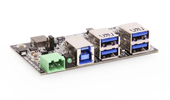USB devices have long had a reputation for simple plug-and-play connections. As more and more of these devices are deployed to people’s homes or they wear them everywhere, this is an increasingly valuable feature. People want to hook them up and use them without the help of a computer expert. They want to be confident that the gadgets which monitor their health will keep working reliably.
Using a USB connector is a good first step, but it’s not the whole picture. The software which accepts data from the devices needs to understand it. Widely accepted standards for USB medical devices make achieving this goal possible A device that complies can work with software from multiple vendors, and patients and medical professionals can use the applications that best meet their needs.
USB for the End-User
Personal health devices (PHDs) aren’t just found in hospitals and medical offices anymore. They’re increasingly available to patients wherever they are for ongoing monitoring of their status. Diabetics and people with high blood pressure can catch abnormal readings and take action in time to avoid a crisis.
The physical interfaces for PHDs include wireless, USB, Thunderbolt, and others. USB offers the advantages of high speed and ease of connection. Most desktops, laptops, tablets, and phones offer a USB connection. It’s more reliable than Bluetooth or Wi-Fi. Inexperienced users can make mistakes that compromise the security of wireless connections, but a USB cable is a safe data conduit. Newer versions of USB are backward compatible with old ones. The current standard is USB 3.1, and a still faster USB 4 is expected to appear this year.
Standardization at the Data Level
Medical devices deal in specialized data, and they need a high level of reliability without room for misinterpretation. Every device sends data using a particular format and data model. The software needs to understand them in order to do anything with the data.
Much of the industry has adopted the IEEE 11073 family of standards to maximize interoperability. It provides a framework for data which is independent of the transport mechanism. The standards define roles for agents, which are devices that collect and transmit data, and managers, which receive and process it and may direct the agents. The standards include specializations for different kinds of agents, such as heart rate monitors and thermometers. Each specialization has its own data model.
Conformance to IEEE 11073 greatly simplifies the job of connecting a PHD and using its data. Applications which understand a device’s specialization will be able to ingest its data, give reports, and issue alerts with few difficulties. Adherence to these standards is a sign that the manufacturer takes the product seriously for medical purposes.
The Medical Applications USB Stack
In between the data model and the physical connection are many protocol details. The USB standards include the Personal Healthcare Device Class, which is supported in the application rather than the operating system’s USB driver.
The Continua Alliance, a consortium recommending standards for medical systems, has endorsed the Medical Applications USB Stack. This implementation brings together the standards at the application and USB levels. Application writers don’t have to deal with the low-level issues, so they can focus on the user experience and data management.
When people’s health is at stake, it’s important for devices to “just work.” The availability of these standards lets medical professionals confidently recommend devices and software that work well together. Compliant USB devices are easy to configure, work reliably, and are compatible with a growing body of software.
Coolgear offers state-of-the-art USB medical devices that earn patients’ confidence. Contact us to find out more.




















